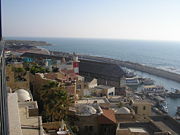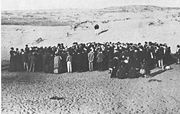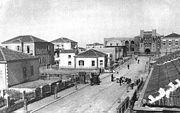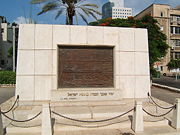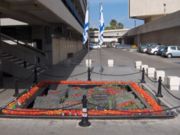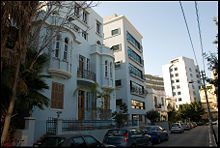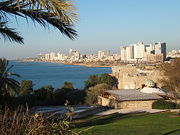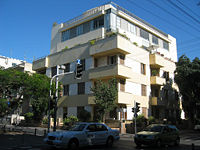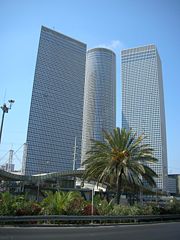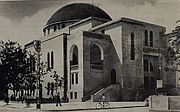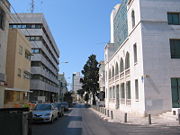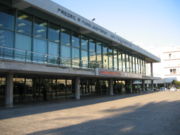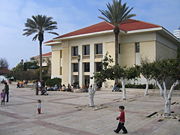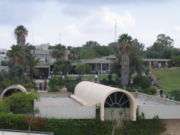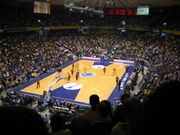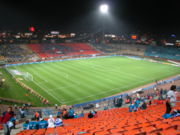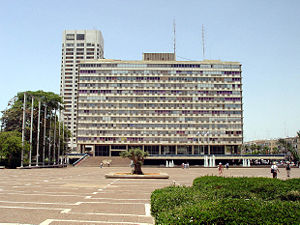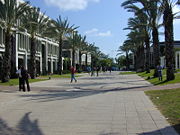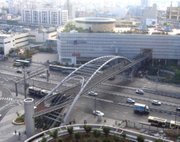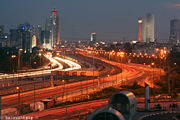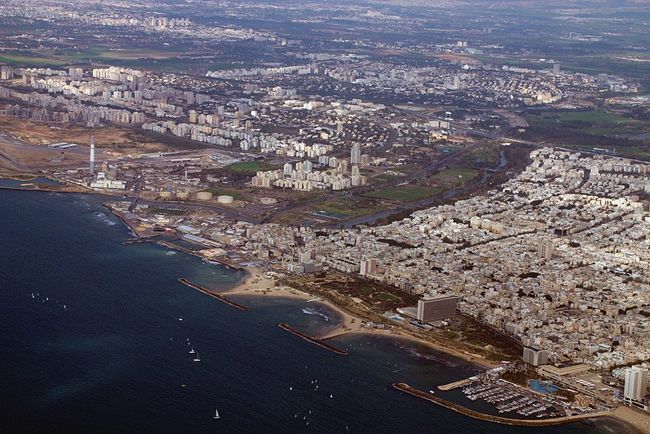Tel Aviv
2008/9 Schools Wikipedia Selection. Related subjects: Geography of the Middle East
| Tel Aviv | ||
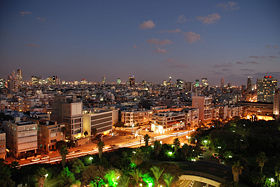 Skyline at night |
||
|
||
| Hebrew | תֵּל־אָבִיב-יָפוֹ | |
| Name meaning | Spring Hill | |
| Founded in | 1909 | |
| Government | City | |
| District | Tel Aviv | |
| Population | 384,400 Metropolitan Area: 3,150,800 (2006) |
|
| Jurisdiction | 51,788 dunams (51.788 km²/19.995 sq mi) | |
| Mayor | Ron Huldai | |
| Website | www.tel-aviv.gov.il | |
Tel Aviv-Yafo (Hebrew: תֵּל־אָבִיב-יָפוֹ Arabic: تل أبيب, Tal ʾAbīb) (usually Tel Aviv) is the second-largest city in Israel, with an estimated population of 384,400. Tel Aviv is situated on the Israeli Mediterranean coastline, covering 51.8 square kilometres (20.0 sq mi). It is the largest and most populous city in Israel's largest metropolitan area known as Gush Dan, home to 3.15 million people as of 2007. The city is governed by the Tel Aviv-Yafo municipality, headed by Ron Huldai.
Tel Aviv was founded in 1909 on the outskirts of the ancient port city of Jaffa (Hebrew: יָפוֹ, Yafo). The growth of Tel Aviv soon outpaced Jaffa, which was largely Arab at the time. Tel Aviv and Jaffa were merged into a single municipality in 1950, two years after the establishment of the State of Israel. Tel Aviv's White City, designated a UNESCO World Heritage Site in 2003, comprises the world's largest concentration of Modernist-style buildings.
Tel Aviv is Israel's economic hub, home of the Tel Aviv Stock Exchange and many corporate offices and research and development centers. Its beaches, cafes, upscale shopping and secular lifestyle have made it a popular tourist destination. It is the country's cultural capital and a major performing arts centre. In the 2008 Mercer cost of living survey, Tel Aviv was ranked as the most expensive city in the Middle East and the 14th most expensive in the world.
Etymology
The name Tel Aviv (literally "Hill of Spring") was chosen in 1910 from many suggestions, among them "Herzliya". Tel Aviv is the Hebrew title of Theodor Herzl's book Altneuland ("Old New Land"), translated from German by Nahum Sokolow. Sokolow took the name from the Book of Ezekiel: "Then I came to them of the captivity at Tel Aviv, that lived by the river Chebar, and to where they lived; and I sat there overwhelmed among them seven days." This name was found fitting as it embraced the idea of the renaissance of the ancient Jewish homeland. Aviv is Hebrew for "spring", symbolizing renewal, and tel is an archaeological site that reveals layers of civilization built one over the other. Theories vary about the etymology of Jaffa or Yafo in Hebrew. Some believe that the name derives from yafah or yofi, Hebrew for "beautiful" or "beauty". Another tradition is that Japheth, son of Noah, founded the city and that it was named for him.
History
Jaffa
Jaffa is an ancient port and has changed hands many times in the course of history. A series of archeological excavations, between 1955 and 1974, revealed traces of towers and gates from the Middle Bronze Age. Subsequent excavations, from 1997 onwards, helped date earlier discoveries. They also exposed sections of a packed-sandstone glacis and a "massive brick wall", dating from the Late Bronze Age as well as a temple "attributed to the Sea Peoples" and dwellings from the Iron Age. Remnants of buildings from the Persian, Hellenistic and Pharaonic periods were also discovered.
The city is first mentioned in letters from 1470 BCE that record its conquest by Egyptian Pharaoh Thutmose III. Jaffa is mentioned several times in the Bible, as the port from which Jonah set sail for Tarshish; as bordering on the territory of the Tribe of Dan; and as the port at which the wood for Solomon's Temple in Jerusalem arrived from Lebanon.
In 1099, the Christian armies of the First Crusade, led by Godfrey of Bouillon occupied Jaffa, which had been abandoned by the Muslims, fortified the town and improved its harbour. As the County of Jaffa, the town soon become important as the main sea supply route for the Kingdom of Jerusalem. Jaffa was captured by Saladin in 1192 but swiftly re-taken by Richard Coeur de Lion, who added to its defenses. In 1223, Emperor Frederick II added further fortications. Crusader domination ended in 1268, when the Mamluk Sultan Baibars captured the town, destroyed its harbour and razed its fortifications. To prevent further Crusader incursions, the city was ransacked in 1336, 1344 and 1346 by Nasir al-Din Muhammad. In the 16th century, Jaffa was conquered by the Ottomans and was administered as a village in the sanjak of Gaza. According to some sources it has been a port for at least 4,000 years, Napoleon besieged the city in 1799 and killed scores of inhabitants; a plague epidemic followed, decimating the remaining population.
Jaffa began to grow as an urban centre in the early 18th century, when the Ottoman government in Constantinople intervened to guard the port and reduce attacks by Bedouins and pirates. However, the real expansion came during the 19th century, when the population grew from 2,500 in 1806 to 17,000 in 1886.
From 1800 to 1870, Jaffa was surrounded by walls and towers, which were torn down to allow for expansion as security improved. The sea wall, 2.5 metres (8.2 ft) high, remained intact until the 1930s, when it was built over during a renovation of the port by the British Mandatory authorities. During the mid-19th century, the city grew prosperous from trade, especially of silk and Jaffa oranges, with Europe. In the 1860s Jaffa's small Sephardic community was joined by Jews from Morocco and small numbers of European Ashkenazi Jews, making by 1882 a total Jewish population of more than 1,500.
During the 1880s, Ashkenazi immigration to Jaffa increased with the onset of the First Aliyah. The new arrivals were motivated more by Zionism than religion and came to farm the land and engage in productive labor. In keeping with their pioneer ideology, some chose to settle in the sand dunes north of Jaffa. The beginning of modern-day Tel Aviv is marked by the construction of Neve Tzedek, a neighbourhood built by Ashkenazi settlers between 1887 and 1896.
Urban development
The Second Aliyah led to further expansion. In 1906, a group of Jews, among them residents of Jaffa, banded together to build a new garden suburb on the outskirts of Jaffa. The goal of the Ahuzat Bayit (lit. "homestead") society was to build a "Hebrew urban centre in a healthy environment, planned according to the rules of aesthetics and modern hygiene". In 1908, the group purchased 5 hectares (12 acres) of dunes northeast of Jaffa which were divided into 60 plots. Meir Dizengoff, who later became Tel Aviv's first mayor, was a member of Ahuzat Bayit. His vision for Tel Aviv involved peaceful co-existence with the Arabs.
Another housing society, Nahalat Binyamin, began to build on April 11, 1909, after holding a lottery to divide up the land. Within a year, Herzl, Ahad Ha‘am, Judah Halevi, Lilienblum, and Rothschild streets were built; a water system was installed; and 66 houses (including some on six subdivided plots) were completed. At the end of Herzl Street, a plot was allocated for a new building for the Herzliya Hebrew High School, founded in Jaffa in 1906. On May 21, 1910, the name Tel Aviv was adopted. Tel Aviv was planned as a European-style garden suburb of Jaffa, with wide streets and boulevards.
By 1914, Tel Aviv had grown to include more than 100 hectares (247 acres), including several new neighborhoods. However, growth halted in 1917 when the Ottoman authorities expelled the Jews of Jaffa. A report published in The New York Times by United States Consul Garrels in Alexandria, Egypt described the Jaffa deportation of early April 1917. The orders of evacuation were aimed chiefly at the Jewish population.
Under the British Mandate
Under British administration, the political friction between Jews and Arabs in Palestine increased.
On May 1, 1921, the Jaffa Riots erupted and an Arab mob killed dozens of Jewish residents. In the wake of this violence, many Jews left Jaffa for Tel Aviv, increasing the population of Tel Aviv from 2,000 in 1920 to 34,000 by 1925. New businesses opened in Tel Aviv, leading to the decline of Jaffa as a commercial centre. In 1925, Patrick Geddes drew up a master plan for Tel Aviv that was adopted by the city council led by Meir Dizengoff. The core idea was the development of a Garden City. The boundaries he worked within, the Yarkon River in the North and Ibn Gvirol Street in the East, are still regarded as Tel Aviv's real city limits although it has since grown beyond them.
Tel Aviv continued to grow in 1926 but suffered an economic setback between 1927 and 1930. At the same time, cultural life was given a boost by the establishment of the Ohel Theatre and the decision of Habima Theatre to make Tel Aviv its permanent base in 1931. Tel Aviv gained municipal status in 1934.
The population rose dramatically during the Fifth Aliyah when the Nazis came to power in Germany. As the Jews fled Europe, many settled in Tel Aviv, bringing the population in 1937 to 150,000, compared to Jaffa's 69,000 residents. Within two years, it had reached 160,000, which was over a third of the country's total Jewish population. Many new immigrants remained after disembarking in Jaffa, turning the city into a centre of urban life. In the wake of the 1936–39 Arab rioting, a local port independent of Jaffa was built in 1938, and Lod Airport (later Ben Gurion Airport) and Sde Dov Airport opened between 1937 and 1938.
Tel Aviv's White City, now a UNESCO World Heritage Site, emerged in the 1930s. Many of the German Jewish architects trained at the Bauhaus, the Modernist school of architecture closed by the Nazis in 1933, fled Germany. Some came to Palestine and adapted the architectural outlook of the Bauhaus as well as other similar schools, to local conditions, creating what is claimed to be the largest concentration of buildings in the International Style in the world.
According to the 1947 UN Partition Plan that proposed dividing Palestine into Jewish and Arab states, Tel Aviv, by then a city of 230,000, was slated for inclusion in the Jewish state. Jaffa with, as of 1945, a population of 101,580 people, 53,930 of whom were Muslim and 16,800 Christian, making up the Arab population, and 30,820 Jewish, was designated as part of the Arab state. The Arabs, however, rejected the partition plan. Between 1947 and 1948, tensions grew on the border between Tel Aviv and Jaffa, with Arab snipers firing at Jews from the minaret of the local mosque. The Haganah and Irgun retaliated with a siege on Jaffa. From April 1948, the Arab residents began to leave. When Jaffa was conquered by Israeli forces on May 14, few remained.
After Israeli independence
By the time of Israel's Declaration of Independence on May 14, 1948, the population of Tel Aviv had risen to more than 200,000. Tel Aviv was the temporary capital of the State of Israel until the government moved to Jerusalem in December 1949. However, due to the international dispute over the status of Jerusalem, most foreign embassies remained in or near Tel Aviv. In the early 1980s, 13 embassies in Jerusalem moved to Tel Aviv as part of the UN's measures responding to Israel's 1980 Jerusalem Law. Today, all but two of the national embassies are in Tel Aviv or the surrounding district. In April 1949, Tel Aviv and Jaffa were united in the single municipality of Tel Aviv-Yafo, and the lands of neighboring villages such as al-Shaykh Muwannis, Jammasin and Sumail, which had been depopulated during the war, were incorporated into the municipality. Tel Aviv thus grew to 42 square kilometers (16.2 sq mi). In 1949, a memorial to the 60 founders of Tel Aviv was constructed. Over the past 60 years, Tel Aviv has developed into a secular, liberal-minded city with a vibrant nightlife and café culture.
In the 1960s, some of the city's Modernist Bauhaus buildings were demolished and replaced by the country's first high-rise buildings, among them the Shalom Meir Tower, which was Israel's tallest building until 1999. Tel Aviv's population peaked in the early 1960s at 390,000, representing 16 percent of the country's total. A long period of steady decline followed, however, and by the late 1980s the city had an aging population of 317,000. High property prices pushed families out and deterred young people from moving in.
At this time, gentrification started taking place in the poorer southern neighborhoods and the old port area in the north was renewed. New laws were introduced to protect the Modernist buildings, and their preservation was further helped by their gaining of UNESCO status. The early 1990s saw the population decline reverse in part due to the large wave of immigrants from the former Soviet Union. The 1990s also saw the emergence of Tel Aviv as a high-tech centre. The construction of many skyscrapers and hi-tech office buildings followed, as Tel Aviv moved into a new phase in its development. In 1993 Tel Aviv was, for the first time, mentioned as a World City by Kellerman who emphasized the existence of "leading economic functions typical for the late 20th century city: hi-tech industries and a modern service economy." The city is regarded to be a strong candidate global city with many of the key characteristics of World Cities being present.
On November 4, 1995, Israel's prime minister, Yitzhak Rabin, was assassinated at a rally in Tel Aviv in support of the Oslo peace accord. The outdoor plaza where this occurred, formerly known as Kikar Malchei Yisrael, was renamed Rabin Square.
Tel Aviv has suffered from violence by Palestinian terrorist groups since the post- First Intifada period. The first suicide attack in Tel Aviv occurred on October 19, 1994, on the Line 5 bus, when a bomber killed himself and 21 civilians as part of a Hamas suicide campaign. The most deadly attack occurred on June 1, 2001, during the Second Intifada, when a suicide bomb exploded inside a nightclub called the Dolphi Disco, and 21 were killed and more than 100 were injured. The most recent attack in the city occurred on April 17, 2006, when 11 people, many of them foreign laborers, were killed and dozens wounded in another suicide attack in the same location.
In recent years, Tel Aviv has seen increasing support towards green issues with the city turning its lights off as part of Earth Hour in March 2008.
Geography
Tel Aviv is located around on the Israeli Mediterranean Coastal Plain, the historic land bridge between Europe, Africa, and Asia. Immediately north of the ancient port of Jaffa, Tel Aviv lies on land that used to be sand dunes and as such has relatively poor soil fertility. The land has been flattened and has no important gradients; its most notable geographical features are bluffs above the Mediterranean coastline and the Yarkon River mouth. Because of the expansion of Tel Aviv and the Gush Dan region, absolute borders between Tel Aviv and Jaffa and between the city's neighborhoods do not exist. The city is 60 kilometers (37 mi) northwest of Jerusalem and 90 kilometers (56 mi) south of the northern port city of Haifa. Neighboring cities and towns include Herzliya to the north, Ramat HaSharon to the northeast, Ramat Gan and Giv'atayim to the east, Holon to the southeast, and Bat Yam to the south. The city is economically stratified between the north and south. South Tel Aviv is generally poor, with the exception of the Neve Tzedek neighbourhood and some recent development by the Jaffa beach. It also includes the city's " downtown." Central Tel Aviv includes Tel Aviv's Azrieli Centre and is also an important financial and commerce district that stretches along the part of Ramat Gan on the Ayalon Highway. The northern side of Tel Aviv is home to Tel Aviv University and some of Tel Aviv's most expensive upper class residential neighborhoods. The prosperity of the north stretches to neighboring Herzliya Pituah, Ramat HaSharon, and Kfar Shmaryahu.
Climate
Tel Aviv has a Mediterranean climate with hot summers, pleasant springs and autumns, and mild, wet winters ( Köppen climate classification Csa). Humidity tends to be high year-round due to the city's proximity to the sea. In winter, temperatures seldom drop below 5 °C (40 °F) and are usually between 10 °C (50 °F) and 15 °C (60 °F); the city has not seen proper snow since 1950. In summer the average is 26 °C (80 °F), and often daytime temperatures exceed 32 °C (90 °F). Despite the high humidity, precipitation during summertime is rare. The average annual rainfall is 530 millimeters (20.9 in), usually concentrated in the period October to April. Tel Aviv experiences on average more than 300 sunny days a year. The record high temperature the city has seen is 43 °C (110 °F), whilst the city's record low is −1.9 °C (30 °F).
| Weather averages for Tel Aviv | |||||||||||||
|---|---|---|---|---|---|---|---|---|---|---|---|---|---|
| Month | Jan | Feb | Mar | Apr | May | Jun | Jul | Aug | Sep | Oct | Nov | Dec | Year |
| Average high °C (°F) | 17.5 (63.5) | 17.7 (63.7) | 19.2 (66.6) | 22.8 (73.0) | 24.9 (76.8) | 27.5 (81.5) | 29.4 (84.9) | 30.2 (86.4) | 29.4 (84.9) | 27.3 (81.1) | 23.4 (74.1) | 19.2 (66.6) | 24.0 (75.2) |
| Average low °C (°F) | 9.0 (48.5) | 9.8 (49.6) | 11.5 (52.7) | 14.4 (57.9) | 17.3 (63.1) | 20.6 (69.1) | 23.0 (73.4) | 23.7 (74.7) | 22.5 (72.5) | 19.1 (66.4) | 14.6 (58.3) | 11.2 (52.2) | 16.4 (61.5) |
| Precipitation mm (inches) | 126.9 (8.8) | 90.1 (5.0) | 60.6 (0.9) | 18.0 (0.1) | 2.3 (0.3) | 0 (0) | 0 (0) | 0 (0) | 0.5 (0) | 26.3 (0.1) | 79.3 (2.5) | 126.4 (3.9) | 530.5 (21.5) |
| Source: World Weather Information Service | |||||||||||||
Districts
Tel Aviv is made up of nine districts that have formed naturally over the city's short history. The most notable of these is Jaffa, the ancient port city out of which Tel Aviv grew. This area is traditionally made up demographically of a greater percentage of Arabs, but recent gentrification is replacing them with a young professional population. Similar processes are occurring in nearby Neve Tzedek, the original Jewish neighbourhood outside of Jaffa. Ramat Aviv, a neighbourhood in the northern part of the city largely made up of luxury apartments and including the Tel Aviv University, is currently undergoing extensive expansion and is set to absorb the beachfront property of Sde Dov Airport after its decommissioning. This will likely take several years while expansion north of the airport makes up the majority of the city's growth.
Historically, there was a demographic split between the Ashkenazi and Europeans north of the city, including the neighbourhood of Ramat Aviv, and the southern, more Sephardi and Mizrahi neighborhoods including Neve Tzedek and Florentin.
Since the 1980s, however, restoration and gentrification has taken place on a large scale in the southern neighborhoods, making them some of the city’s most desirable neighborhoods for the more prosperous north Tel Avivis. In north Tel Aviv, the old port area, which had become run-down since the port was decommissioned in 1965, also saw an urban revival, becoming an upmarket area with shops and restaurants.
Architecture
The early architecture of Tel Aviv consisted largely of Eastern European-style single-story houses with red-tiled roofs. Neve Tzedek, the first neighbourhood to be constructed outside of Jaffa is characterised by two-story sandstone buildings. By the 1920s, a new eclectic Orientalist style came into vogue, combining European architecture with Middle Eastern features such as arches, domes and ornamental tiles. Municipal construction followed the "garden city" master plan drawn up by Patrick Geddes. Two- and three-story buildings were interspersed with boulevards and public parks. Bauhaus architecture was introduced in the 1920s and 1930s by German Jewish architects who settled in Palestine after the rise of the Nazis. Tel Aviv's White City, in north Tel Aviv, contains more than 5,000 Modernist-style buildings inspired by the Bauhaus school and Le Corbusier. Construction of these buildings, later declared protected landmarks and, collectively, a UNESCO World Heritage Site, continued until the 1950s in the area around Rothschild Boulevard. Three thousand buildings were created in this style between 1931 and 1939 alone.
In the 1960s, this architectural style gave way to office towers and a chain of waterfront hotels and commercial skyscrapers. Some of the city's Modernist buildings were neglected to the point of ruin. Before legislation to preserve this landmark architecture, many of the old buildings were demolished. In recent years, efforts have been made to refurbish Bauhaus buildings and restore them to their original condition. In recent years, Tel Aviv has become a hub of modern high-rise architecture due to the soaring price of real-estate in the city. The Shalom Meir Tower, Israel's first skyscraper, was built in Tel Aviv in 1965 and remained the country's tallest building until 1999. The Azrieli Centre, composed of three buildings— one square, one triangular, and one circular—usurped that title. Since 2001, Israel's tallest building is the City Gate Tower, which is located in the neighboring city of Ramat Gan, although the country's tallest wholly residential building, the Neve Tzedek Tower, is in Tel Aviv. New neighborhoods such as the Park Tzameret are being constructed to house luxury apartment towers including YOO Tel Aviv towers designed by Philippe Starck, while zones such as The southern Kirya are being developed with office towers. Other recent additions to Tel Aviv's skyline are the 1 Rothschild Tower, Be'eri Nahardea Tower and First International Bank Tower.
Demographics
| City of Tel Aviv Population by year |
|
| 1920 | 2,000 |
| 1925 | 34,000 |
| 1937 | 150,000 |
| 1939 | 160,000 |
| 1948 | 200,000 |
| 1960 | 390,000 |
| 1989 | 317,000 |
| 2008 | 384,400 |
The city has a population of 384,400 spread over an area of 51,788 dunams (51.8 km²) (20 mi²), yielding a population density of 7,445 people per square kilometer (2,875 per square mile). According to the Israel Central Bureau of Statistics (CBS), as of June 2006 Tel Aviv's population is growing at an annual rate of 0.9%. It consists of 91.8% Jews, 4.2% Arabs and 4.0% others ( Christians, Buddhists). The city is relatively multicultural, and languages such as Tagalog, Thai, Russian, Arabic, French and English are often spoken aside Hebrew. According to some estimates, about 50,000 unregistered Asian foreign workers live in the city. Compared with other Westernised cities, crime in Tel Aviv is relatively low.
According to Tel Aviv-Yafo Municipality, the average income in the city is 20% above the national average, with an unemployment rate of 6.9%. The city's education standards are above the national average: of its 12th-grade students, 64.4% are eligible for matriculation certificates, the qualification received by high school graduates. The age profile is relatively even, with 22.2% aged under 20, 18.5% aged 20–29, 24% aged 30–44, 16.2% aged between 45 and 59, and 19.1% older than 60.
Tel Aviv's population reached a peak in the early 1960s at around 390,000, falling to 317,000 in the late 1980s as high property prices forced families out and deterred young couples from moving in. Since the mass immmigration from the former Soviet Union in the 1990s, the population has risen steadily. Today, the city's population is young and growing. In 2006, 22,000 people moved to the city, while only 18,500 left, and many of the new families had young children. The population of Tel Aviv is expected to reach 450,000 by 2025; meanwhile, the average age of residents in the city fell from 35.8 in 1983 to 34 in 2008. The population over age 65 stands at 14.6% compared with 19% in 1983.
Religion
Despite its image as a secular city, Tel Aviv has about a hundred synagogues, including historic buildings such as the Great Synagogue, established in the 1930s. In recent years, a centre for secular Jewish Studies and a "secular yeshiva" have opened in the city. Tensions between religious and secular Jews before the gay pride parade ended in vandalization of a synagogue
One of Tel Aviv's famous landmarks is the Hassan Bek Mosque, on the beachfront. Jaffa is home to a sizable Muslim and Christian population. The number of churches has grown in recent years to accommodate the religious needs of diplomats and foreign workers.
The Tel Aviv District is 93 percent Jewish, 1 percent Muslim, and 1 percent Christian. The remaining 5 percent are not classified by religion.
Economy
Since Tel Aviv was built on sand dunes, farming was not profitable and maritime commerce was centered in Haifa and Ashdod. Instead, the city gradually developed as a centre for scientific and technical research. In 1974, Intel opened its first overseas research and development operation in the city, and Tel Aviv emerged as a high-tech centre in the 1990s. Economic activities in the city account for about 15 percent of national employment and about 17 percent of GDP. Forty percent of national employment in finance and 25 percent of national employment in business services is in the city.
The economy of Tel Aviv has developed dramatically over the past decades. The city has been described as a flourishing technological centre by Newsweek and a "miniature Los Angeles" by The Economist. Many computer scientists, their numbers increased by immigration from the former Soviet Union since the early 1990s, live and work in Tel Aviv. In 1998, the city was described by Newsweek as one of the top 10 most technologically influential cities in the world. Since then, high-tech industry in the Tel Aviv area has developed even more. The Tel Aviv metropolitan area (including satellite cities such as Herzliya and Petah Tikva) is Israel's centre of high-tech and is sometimes referred to as Silicon Wadi. Tel Aviv is home to the Tel Aviv Stock Exchange (TASE), Israel's only stock exchange, which has reached record heights since the 1990s. Many international venture-capital firms, scientific research institutes and high-tech companies are headquartered in the city. Industries in Tel Aviv include chemical processing, textile plants and food manufacturers. The city's nightlife, cultural attractions and architecture attract tourists whose spending benefits the local economy.
The Globalization and World Cities Study Group and Network (GaWC) at Loughborough University has constructed an inventory of world cities based on their level of advanced producer services. The inventory lists Tel Aviv as having "strong evidence" of world city formation—the highest ranking for a Middle Eastern city with the exception of partly-European Istanbul.
Nine of the fifteen Israeli billionaires live in Israel; four live in Tel Aviv or its suburbs, according to Forbes. According to Mercer, a human resources consulting firm based in New York, as of 2008 Tel Aviv is the most expensive city in the Middle East and the 14th most expensive in the world. It falls just behind Singapore and Paris and just ahead of Sydney and Dublin in this respect.
Culture
Tourism and recreation
As a Mediterranean city, Tel Aviv is a magnet for international tourism likened by some to Barcelona. According to the Tel Aviv-Yafo Municipality, it has 44 hotels with more than 5,800 rooms. Tel Aviv has been called "the city that never sleeps" because of its nightlife and 24-hour culture.
Tel Aviv's largest public park is Park HaYarkon. Other parks such as Gan Meir and Dubnow Park are located in the city centre area. Seventeen percent of the city is covered in plants. Dizengoff Centre was Israel's first mall. Tel Aviv has branches of some of the world's leading hotels, among them the Crowne Plaza, Sheraton, Dan, Isrotel and Hilton. It is home to many museums, architectural and cultural sites, and city tours are available in different languages. Apart from bus tours, there are architectural tours and Segway tours and walking tours. The nightlife is particularly active around the beachfront promenades because of its many nightclubs and bars. The city has a wide variety of restaurants offering traditional Israeli dishes as well as international fare. More than 100 sushi restaurants, the third highest concentration in the world, do business in the city, and an Italian restaurant in Tel Aviv was called the best Italian restaurant outside of Italy by the Italian Ministry of Agriculture.
Tel Aviv is more accepting of lesbians, gays, bisexuals, and transgender-transsexuals LGBT than any other city in the country and the region and has a well established LGBT community. The city hosts a pride parade that attracts thousands annually and in early 2008 it hosted Israel's first sex festival.
Arts and theatre
Tel Aviv is a major cultural centre of Israel. Eighteen of Israel's 35 major centers for the performing arts are located in the city, including five of the country's nine large theaters, where 55% of all performances in the country and 75% of all attendance occurs. The Tel Aviv Performing Arts Centre is the home of the Israeli Opera, where Plácido Domingo was house tenor between 1962 and 1965, and the Cameri Theatre. With 3,000 seats, the Fredric R. Mann Auditorium (Heichal Hatarbut) is the city's largest theatre. Habima Theatre, Israel's national theater, was closed down for renovations in early 2008. Enav Cultural Centre is one of the newer additions to the cultural scene. Other theaters in Tel Aviv are the Gesher Theater and Beit Lessin Theatre; Tzavta and Tmuna are smaller theaters that host musical performances and fringe productions. In Jaffa, the Simta and Notzar theaters specialize in fringe style.
Tel Aviv is home to a number of established dance centers and companies. The Batsheva Dance Company, a contemporary dance troupe, as well as Bat Dor and the Israel Ballet are also headquartered in Tel Aviv. Tel Aviv's center for modern and classical dance is the Suzanne Dellal Centre in Neve Tzedek.
Opera and classical music performances are held daily in Tel Aviv. Many of the world's leading classical conductors and soloists have performed on Tel Aviv stages. Tel Aviv's Park HaYarkon is sometimes used as a popular venue for pop rock concerts.
The Tel Aviv Cinemathèque screens art movies, premieres of short and full-length Israeli films, and hosts a variety of film festivals, among them the Festival of Animation, Comics and Caricatures, the Student Film Festival, the Jazz, Film and Videotape Festival and Salute to Israeli Cinema. The city has several multiplex cinemas.
Museums
Israel is said to have the highest number of museums per capita of any country, three of the largest of which are in Tel Aviv. Among these are the Eretz Israel Museum, known for its collection of archaeology and history exhibits dealing with the Land of Israel, and the Tel Aviv Museum of Art. Housed on the campus of Tel Aviv University is the Beth Hatefutsoth, a museum of the international Jewish diaspora that tells the story of Jewish prosperity and persecution throughout the centuries of exile. Batey Haosef Museum specializes in Israel Defense Forces' military history. The Palmach Museum near Tel Aviv University offers a multimedia experience of the history of the Palmach as well as archives depicting the lives of Jewish soldiers who became Israel's first defenders. Near Charles Clore's garden in north Jaffa is a small museum of the Etzel Jewish militant organization, which conquered Jaffa in the 1948 Arab-Israeli War. The Tel Aviv Exhibition Centre in the northern part of the city hosts more than 60 major events a year. Many offbeat museums and galleries operate in the city's southern areas, including the Tel Aviv Raw Art contemporary art gallery.
Sports
Tel Aviv is home to some of the top sports teams in Israel, including a world-class basketball team. It is the only city with three teams in Ligat ha'Al, the country's top football league. Maccabi Tel Aviv Sports Club was founded in 1906 and competes in more than 10 sports. Its Maccabi Tel Aviv Basketball Club holds 47 Israeli titles, has won 36 editions of the Israel cup, and has five European Championships, and its Maccabi Tel Aviv F.C. holds 18 Israeli league titles and has won 22 editions of the Israel cup, two Israel Toto cups and two Asia cups. Yael Arad, an athlete in Maccabi's judo club, won a silver medal in the 1992 Olympic Games.
Hapoel Tel Aviv Sports Club was founded in 1923 and has included more than 11 sports clubs including the Hapoel Tel Aviv Football Club (13 Israeli championships, 11 Israeli cups, one Toto cup and one Asia champion), a kayaking club, and a women's basketball club.
Bnei Yehuda Tel Aviv's football club (once Israeli champion, twice State Cup winners and twice Toto Cup winner) is the only Israeli football team in the top division that represents a neighbourhood, the Hatikva Quarter in Tel Aviv, and not a city.
Other football clubs in the top division were Shimshon Tel Aviv and Beitar Tel Aviv, which has merged into one team, Beitar/Shimshon Tel Aviv, in the third division, Liga Artzit. Another former first division team, Maccabi Jaffa, played in the lower divisions in the 2007–08 season.
Two rowing clubs operate in Tel Aviv. The Tel Aviv Rowing Club, established as early as 1935 on the banks of the Yarkon River, is the largest rowing club in Israel. Meanwhile, the beaches of Tel Aviv provide a vibrant Matkot (beach paddleball) scene. Tel Aviv Lightning represent Tel Aviv in the Israel Baseball League.
Government
Tel Aviv is governed by a 31-member city council elected for a four-year term in direct proportional elections. All Israeli citizens over the age of 18 with at least one year of residence in Tel Aviv are eligible to vote in municipal elections. The municipality is responsible for social services, community programs, public infrastructure, urban planning, tourism and other local affairs. The Tel Aviv City Hall is located at Rabin Square. As of 2008, Ron Huldai is mayor of Tel Aviv, having held that office since 1998. The longest serving mayor of the city was Shlomo Lahat, who was in office for 19 years. The shortest serving was David Bloch, in office for just two years, 1925–27. The importance of Tel Aviv is further enhanced by the non-recognition of Jerusalem as the Capital of Israel by the international community, which maintains embassies mostly in Tel Aviv. The Israeli Ministry of Defense is in Tel Aviv. Israel Meir Lau is chief rabbi of the city.
The demographic split in the city has also created political divisions between the Labor Party, usually strongest in the north, and Likud and other right-wing and religious parties, usually strongest in the south. In the 2006 election, however this pattern changed when the new centrist Kadima party gained 28 percent of the city's vote, followed by Labor with 20 percent.
Mayors
| Name | Took office | Left office | |
|---|---|---|---|
| 1 | Meir Dizengoff | 1921 | 1925 |
| 2 | David Bloch | 1925 | 1927 |
| 3 | Meir Dizengoff | 1928 | 1936 |
| 4 | Israel Rokach | 1936 | 1952 |
| 5 | Haim Levanon | 1953 | 1959 |
| 6 | Mordechai Namir | 1959 | 1969 |
| 7 | Yehoshua Rabinowitz | 1969 | 1974 |
| 8 | Shlomo Lahat ("Chich") | 1974 | 1993 |
| 9 | Roni Milo | 1993 | 1998 |
| 10 | Ron Huldai | 1998 |
Education
Tel Aviv is home to many schools, colleges, and universities. As of 2006, 51,359 children attended school in Tel Aviv, of whom 8,977 were in municipal kindergartens, 23,573 in municipal elementary schools, and 18,809 in high schools. Sixty-four percent of students in the city are entitled to matriculation, more than 5 percent higher than the national average. Four thousand children are in first grade at schools in the city, and population growth is expected to raise this number to 6,000 by 2012. As a result, 20 additional kindergarten classes will open in 2008–09 in the city, while additional classes will be added at schools in north Tel Aviv. A new elementary school is planned north of Sde Dov as well as a new high school in north Tel Aviv.
Gymnasia Herzlia moved from Jaffa to Tel Aviv in 1909. The school continues to operate, although has moved to Jabotinsky Street. Other notable schools in Tel Aviv include Shevah Mofet, the second Hebrew school in the city, Ironi Alef and Alliance.
Tel Aviv's major institution for higher education is Tel Aviv University. Together with Bar-Ilan University in neighboring Ramat Gan, the student population is more than 50,000, with a sizeable number of international students. Tel Aviv University, founded in 1953, is now the largest university in Israel, internationally known for its physics, computer science, chemistry and linguistics departments. The campus is located in the neighbourhood of Ramat Aviv. Tel Aviv also has several colleges.
Transport
Tel Aviv is a major transportation hub, with many major routes of the national road network passing through the city. The main highway to Tel Aviv is the Ayalon Highway (Highway 20), which runs along the eastern side of the city from north to south along the Ayalon River riverbed, dividing for the most part Tel Aviv and Ramat Gan. Driving south on the Ayalon gives access to Highway 1, leading to Ben Gurion International Airport and Jerusalem. Within the city, the main routes are King George Street, Allenby Street, Ibn Gabirol Street, Dizengoff Street, Rothschild Boulevard, and in Jaffa the main route is Jerusalem Boulevard. Namir Road connects the city to Highway 2, Israel's main north–south highway, and Begin/Jabotinsky Road, which provides access from the east through Ramat Gan, Bnei Brak and Petah Tikva. Tel Aviv, accommodating about 500,000 commuter cars daily, suffers from increasing congestion. In 2007, the Sadan Report recommended the introduction of a congestion charge similar to that of London in Tel Aviv as well as other Israeli cities. Under this plan, road users traveling into the city would pay a fixed fee. Tel Aviv Municipality is trying to encourage the use of bicycles in the city, aiming to open 100 bicycle-rental stations to serve 74 kilometers (46.0 mi) of bicycle paths. Plans call for expansion of the paths to 100 kilometers (62.1 mi) by 2009.
Tel Aviv has four train stations along the Ayalon Highway. The stops are from north to south: Tel Aviv University, Tel Aviv Merkaz, Tel Aviv Hashalom (adjacent to Azrieli Centre) and Tel Aviv Hahaganah (near the Tel Aviv Central Bus Station). It is estimated that over a million people travel by train from the surrounding cities to Tel Aviv each month.
The Tel Aviv Central Bus Station is in the south of the city. The main bus network in Tel Aviv is operated by Dan Bus Company; the Egged Bus Cooperative, the world's second-largest bus company, provides intercity transportation.
Tel Aviv's domestic airport is Sde Dov in the northwestern part of the city. Sde Dov is slated to close because it occupies prime coastal real estate near the upscale Ramat Aviv neighbourhood. In the near future all services to Sde Dov will transfer to Ben Gurion International Airport, Israel's main international airport, close to the city of Lod and 15 kilometres (9 mi) southeast of Tel Aviv. Because it is close to Tel Aviv, Ben Gurion International Airport is often referred to as Tel Aviv International Airport even though it is not part of any municipal jurisdiction.
In early 2008, Tel Aviv Municipality announced a pilot scheme to build charging stations for electric cars. Initially, five charging points will be built, and eventually 150 points will be set up across the city as part of the Israeli electric car project, Project Better Place. Battery replacement points will be located at the city's entrances.
Aerial shots
Sister cities
Tel Aviv is twinned with 27 cities and has a partnership with Los Angeles, California, USA:


